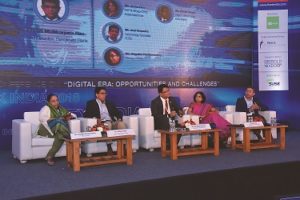At the plenary session of the recent IBEX India 2018, a discussion was held on ‘Sustainable Biz Model for the Digital Era’. Highlights of the discussions:
Panellists

Gayathri Parthasarthy, Partner, KPMG
Shreekant Vijaykar, Director of South Asian Operations, Asia Pacific Region at COPC
Aruna Rao, CTO, Kotak Mahindra Bank
Abhijit Singh, Head – Technology, ICICI Bank
Moderator: Mallikarjuna Rao, ED, Syndicate Bank
Mallikarjuna Rao: The model of merchants paying for digital transactions has gone for a toss with the reduction and MDR. The cost was being borne by the banker, as the customer is not willing.
Aruna Rao: There is no other country than India that offers the range of payment options like RTGS, VISA, RuPay, NEFT, credit cards, debit cards, tap and pay, QR Code, UPI etc. How will it be sustainable? There has to be an income generation. The sensible thing is that the beneficiary must incur the cost, viz the customer. We have to innovate to a point that they are willing to pay some fee. For example, booking a train ticket or hotel or something online, there is a convenience offered to the customer of not having to travel or stand in line. So, the customer is willing to pay a small fee. If you buy insurance online, you will get a lesser price. So, over time I am expecting that the digital transaction will become more feasible than physical transaction.
Mallikarjuna Rao: Prior to 2008, if you were drawing cash from an ATM that is not operated by your bank, you paid a certain fee. Then the regulator made it free across ATMs.
Shreekant Vijaykar: We were commissioned by the Australian Payment Commission and we did it across Australia, China, India and Singapore. The number of satisfied customers in India is 85%. It was much less in Australia and Singapore. Net Promotor Score, or NPR, was about 45%, whereas the overall average was 14%. This could also be due to expectations management. We also looked at customer effort score, which was around 6. This shows that we have a lot of focus on customers. What I want to say is that customer experience is important from sustainability point of view. Customer journey keeps changing. In China, 60% of people use mobile banking, in India, it is 48% and in Australia and Singapore it is even lower. Everyone talks about chatbots. China is ahead of India.
The divide between urban and rural is decreasing.
Mallikarjuna Rao: Use of USSD is increasing. In 2009 there was a huge internet fraud. That is when the regulator introduced 2FA. How is security being improved?
Abhijit Singh: We are moving from cash to digital in one big leap. In other countries, POS has increased first, and then digital. We have a national security officer. 2FA is a big enabler. Even in many developed countries, there is no PIN on card or OTP. The fraud management discipline is changing. They are looking at big data and analytics and looking at whether you are doing a transaction from the same device or a different device. I think sufficient checks and balances have been created.
Gayathri Parthasarthy: To sustain growth, we have to look at all the involved parties – banks, government, service providers, technology providers, regulators and customers. We have to incentivise at every level. We are giving too many apps and options to customers. We need to have some standardization. Also, we need to get the data part right so as to reduce fraud.
Mallikarjuna Rao: No incentive can be permanent in nature. The cost of a biometric device is about Rs 4000. That is too much for a merchant or bank. The Andhra Pradesh government is subsidizing this by 50%. For any model to succeed, there is a need for trust and confidence. For this there must be a quick and simple redressal mechanism.
Vijaykar: Even for a purely digital channel, there is still a need for other channels for complaints, redressal, etc.
Mallikarjuna Rao: Will Bharat Billpay be a game changer?
Abhijit Singh: We feel that interoperable payments are always welcome. In today’s model, the margins are low, and volumes are large. For Bharat Billpay, we see a challenge in penetration. There should also be a very good grievance addressal mechanism.
Mallikarjuna Rao: Mechanisms for fraud?
Aruna Rao: The stakes are going up both sides. The fraud management departments have modernized. But the fraudsters have also upgraded their technology and their organization. So, first we need to educate the customer. We need to give more power to the customer to protect himself, such as turning off and on the debit card. You can give customers ability to limit amounts on cards. Banks can also analyze customer behaviour on various channels and then step up the authentication. This can be easily implemented.
Q form audience: Data is not perfect which leads to customer unhappiness.
Aruna Rao: When the system is seen as suspicious, we put it in a hold mode. We would call the customer and verify, or we do step up information. We turn into a block, when it is an extremely suspicious transaction. Every control brings in some level of inconvenience.
Q: Is India ready for open banking?
Abhijit Singh: India is huge in e-commerce and this indicates that there is a huge amount of interconnectivity between banks and merchants. We are working with 8-10 fintechs to expose APIs.







